Attached files
| file | filename |
|---|---|
| EX-99.1 - EX-99.1 - Cardiff Oncology, Inc. | a17-20309_3ex99d1.htm |
| 8-K - 8-K - Cardiff Oncology, Inc. | a17-20309_38k.htm |
Exhibit 99.2
Transforming Oncology With Precision Cancer Therapeutics Company Overview August 2017 Company Overview January 2017

Forward-Looking Statements Certain statements in this presentation are forward-looking within the meaning of the Private Securities Litigation Reform Act of 1995. These statements may be identified by the use of words such as "anticipate," "believe," "forecast," "estimated" and "intend" or other similar terms or expressions that concern Trovagene's expectations, strategy, plans or intentions. These forward-looking statements are based on Trovagene's current expectations and actual results could differ materially. There are a number of factors that could cause actual events to differ materially from those indicated by such forward-looking statements. While the list of factors presented in the 10-K is considered representative, no such list should be considered to be a complete statement of all potential risks and uncertainties. Unlisted factors may present significant additional obstacles to the realization of forward-looking statements. Forward-looking statements included herein are made as of the date hereof, and Trovagene does not undertake any obligation to update publicly such statements to reflect subsequent events or circumstances.
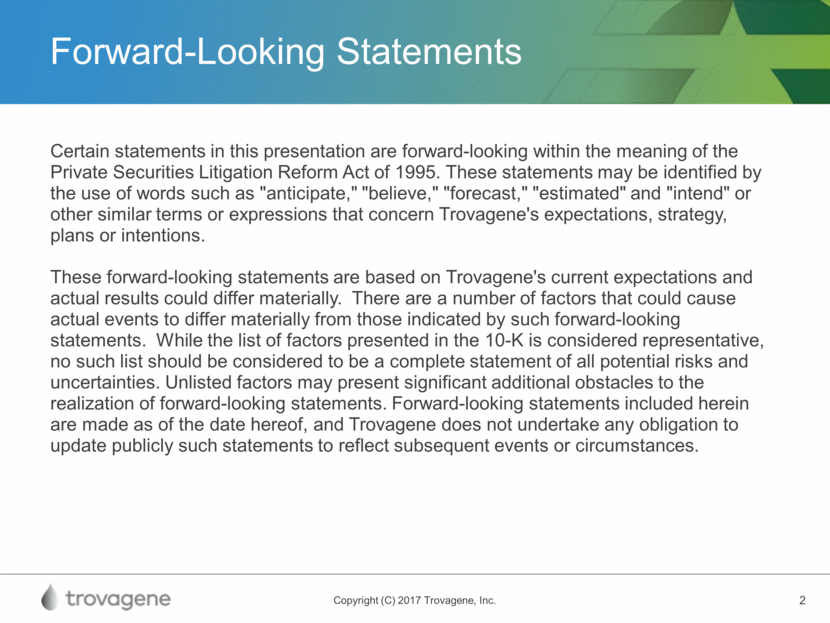
Company Overview Precision Cancer Therapeutics Clinical stage biotechnology company developing treatments for hematological and solid tumor cancers Core DNA/RNA Technology Expertise Proprietary technology in tumor genomics and CLIA/CAP-accredited laboratory for drug development programs Broad Intellectual Property Identify and quantify clinically-actionable biomarkers for predicting patient response to cancer therapeutics NASDAQ: TROV Headquarters: San Diego, CA Shares (07/31/17): 37.3M outstanding
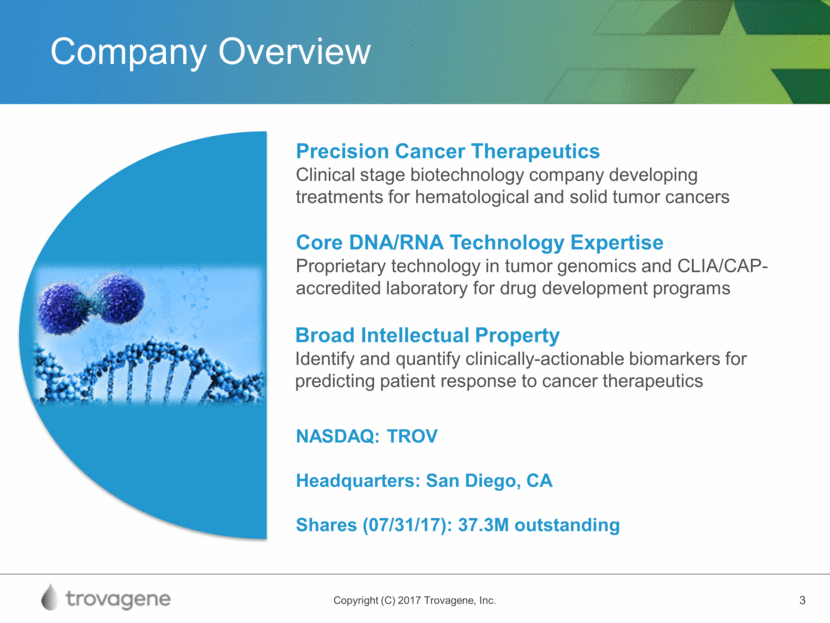
Significant Market Opportunities Investment Highlights FDA approved PCM-075 IND and protocol to conduct Phase 1b/2 clinical trial in acute myeloid leukemia (AML) Phase 1 trial completed in solid tumor cancers; published in Investigational New Drugs Additional phase 2 protocol under development in ACC Progressing Pipeline First-in-class Polo-like kinase (PLK) 1 inhibitor for broad clinical applications Acute myeloid leukemia, Non-Hodgkin Lymphoma Adrenocortical Carcinoma, Castrate-Resistant Prostate, Small-Cell Lung Strong IP Protection Technology Platform 125 issued patents and 56 pending patent applications, globally Patent holder of NPM1 for diagnosis and monitoring therapy response in AML Proprietary biomarker technology to optimize drug development Partnerships with pharma and research institutions to purchase NextCollect™ urine collection and DNA preservation device
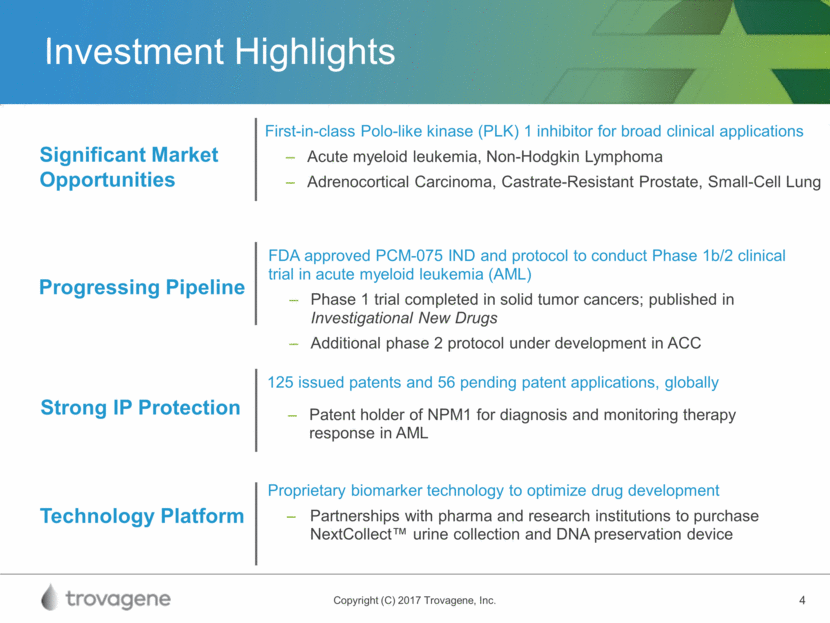
PCM-075 Expanding Pipeline Indication (Target) Preclinical Phase 1 Phase 2 Non-Hodgkin Lymphoma Acute Myeloid Leukemia - Phase 1b/2 combination FDA approved IND / protocol – active Indication (Target) Preclinical Phase 1 Phase 2 Phase 1 Advanced Solid Tumors Completed and published Castrate-Resistant Prostate Small-Cell Lung Adrenocortical Carcinoma Phase 2a protocol in development Liquid Tumors Solid Tumors
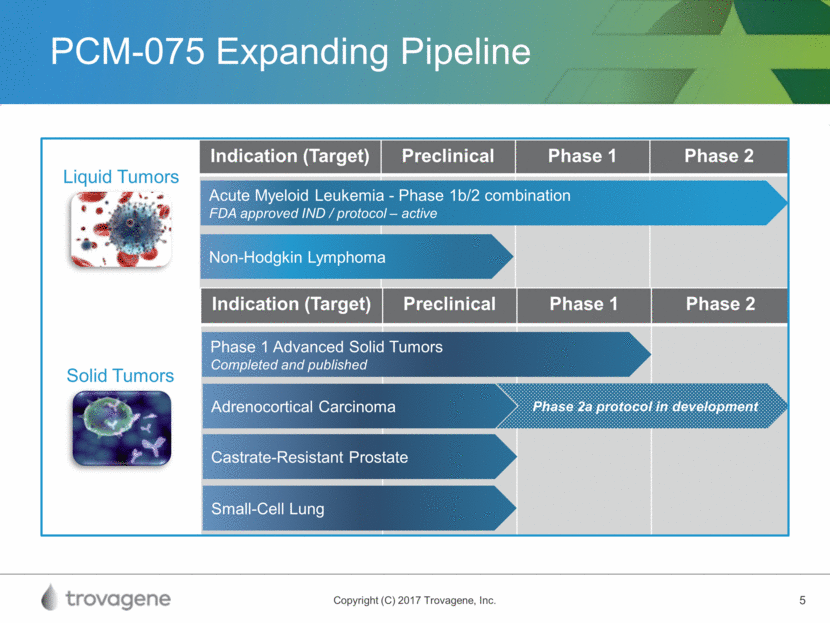
Phase 1 Study Completed in Solid Tumors* Phase 1 Study Design 19 of 21 patients enrolled administered PCM-075 orally, once daily for 5 consecutive days, every 3 weeks PCM-075 Study Results Included: colorectal, pancreatic, lung, sarcomas, hepatocellular, ampullary, prostate, ovarian, skin Open-label dose escalation trial in patients with solid tumor malignancies Established safety of PCM-075 and identified a recommended Phase 2 dose of 24 mg/m2/day 16 of the 19 patients (84.2%) treated with PCM-075, were evaluable for efficacy, with stable disease observed in 5 (31.2%) of the patients Reversible, on-target thrombocytopenia and neutropenia, consistent with the expected mechanism of action, were the primary adverse events One patient experienced grade 3 constipation, which was likely due to concomitant opiate therapy Phase 1 dose escalation study in patients with advanced or metastatic solid tumors * "Phase 1 Dose-Escalation Study of NMS-1286937, an Orally Available Polo-Like Kinase 1 Inhibitor, in Patients with Advanced or Metastatic Solid Tumors," Investigational New Drugs.

PLK1: Target for Cancer Therapy PLK1, PLK2, PLK3 are members of a family of serine/threonine kinases that are important regulators of cell-cycle progression1–6 PLK1 is a master regulator of mitotic progression and is the only family member expressed exclusively in dividing cells1-6 Other members of polo-like kinase family have other cellular functions roles, including tumor suppression and neuron expression1–6 1Takai N, et al. Oncogene 2005;24:287–91; 2Rudolph D, et al. Clin Cancer Res 2009;15:3094–102; 3Chopra P, et al. Expert Opin Investig Drugs 2010;10:27–43; 4Strebhardt K. Nat Rev Drug Discov 2010;9643–60; 5Zitouni S, et al. Nat Rev Mol Cell Biol 2014;15:433–52; 6Takaki T, et al. Curr Opin Cell Bio 2008;20:650–60. PLK1 Anaphase Checkpoint Cytokinesis G1/S Phase Checkpoint G2/M Phase Checkpoint
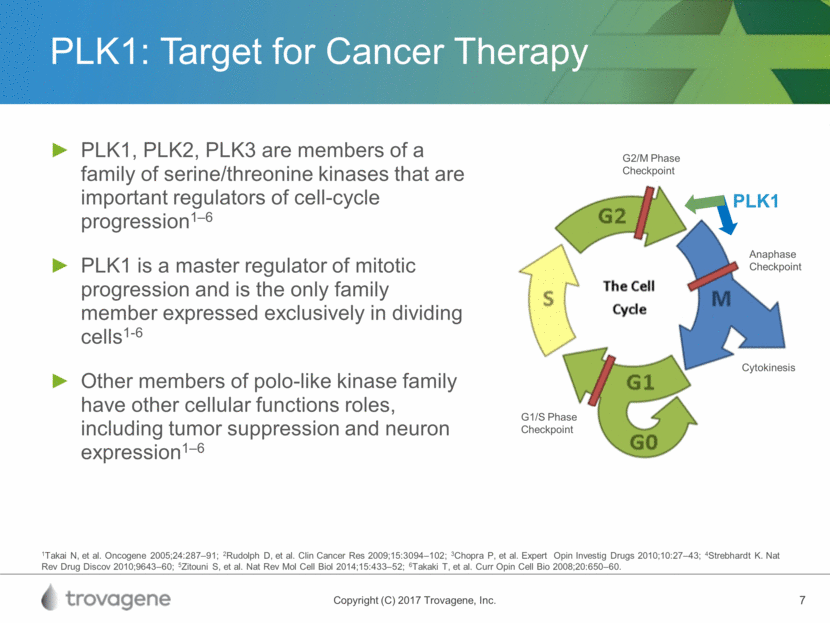
PLK1 As a Cancer Target Higher Expression of PLK1 is Associated with Shorter Overall Survival2 Overexpression of PLK1 Observed in Numerous Cancer Types1 Adrenocortical Carcinoma 1Data derived from The Tumor Genome Atlas, https://tcga-data.nci.nih.gov/docs/publications/tcga; 2Bussey et al. Clin Trans Med, 2016, 5:1 Tumor Type PLK1 Fold Over-Expression AML 13.0 B-cell Lymphoma 56.3 Adrenocortical 4.5 Lung Adeno 10.5 Lung Squamous 20.9 Breast 14.4 Esophageal 7.8 Stomach 2.2 Colon 2.5 Head & Neck 3.1 Skin Melanoma 18.3 Ovarian 31.7
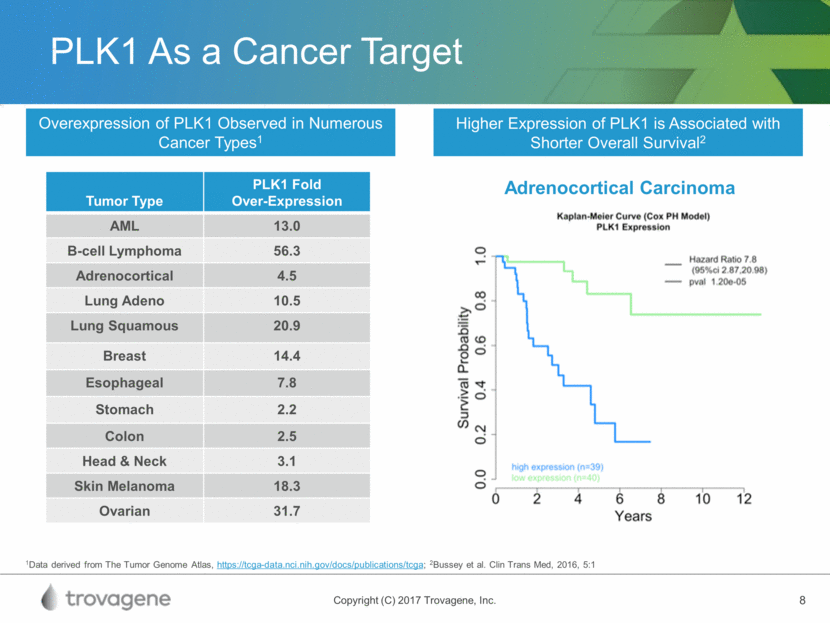
PCM-075: A PLK1 Inhibitor Highly-selective, oral, polo-like kinase 1 (PLK1) inhibitor with demonstrated activity in hematologic and solid tumor cancers Licensed exclusive global development and commercialization rights from Nerviano Medical Sciences, S.r.l. Upfront payment of $2.0 million Milestones (Development: Phase 3; Regulatory: NDA submission; Commercial Launch) Tiered royalty payments up to and over $1.0 billion Trovagene has all rights to manufacturing of bulk and finished goods NerPharMa (subsidiary of Nerviano) FDA approved contract manufacturer for clinical trials Almac drug depot and distribution for execution to clinical trial sites
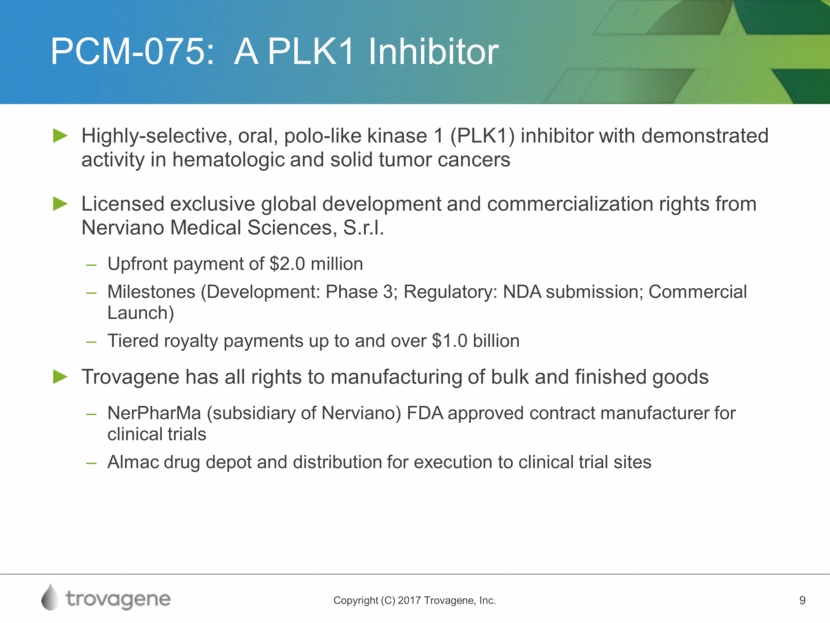
PCM-075 Attributes
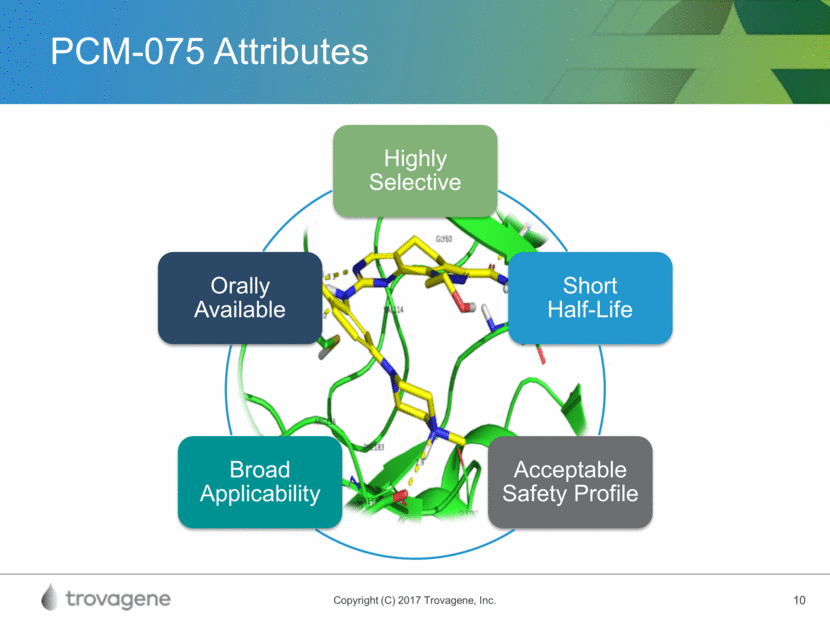
PCM-075 Biochemical Profile Selective, adenosine triphosphate (ATP) competitive PLK1 inhibitor Selectivity driven by polar interaction with the carboxyl side chain of Glutamate 140 position of PLK1 Polo-like kinase 1 (PLK1) inhibitor PLK Member PCM-075 IC50 (nM)1 PLK1 2 PLK2 > 10,000 PLK3 > 10,000 1Data on File, Trovagene, Inc.
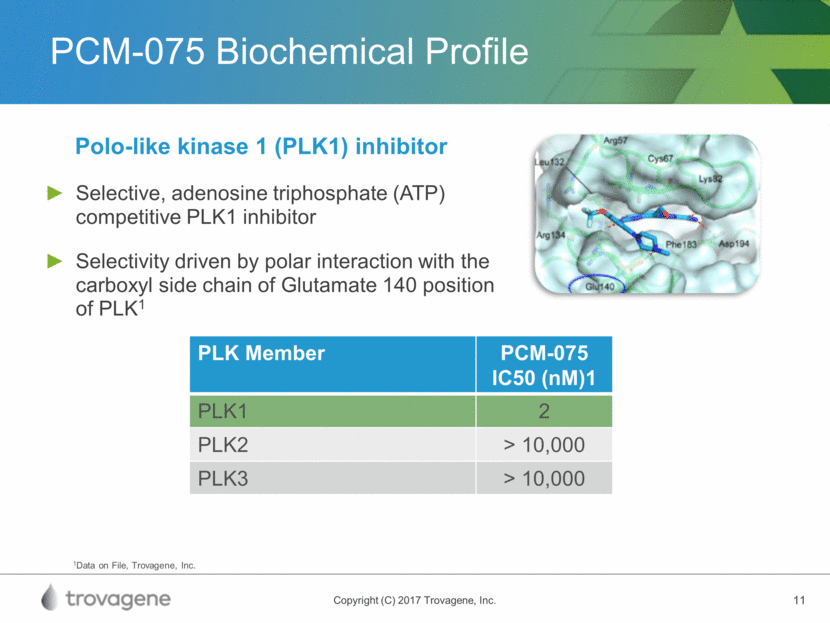
PCM-075 Mechanism of Action Induces a cellular phenotype of G2/M, leading to cell death Clear evidence of in-vitro pathway modulation in AML Mitotic inhibitor demonstrating anti-proliferative activity* AML-NS8 Patient-Derived Cells Treated with 200 nM PCM-075 for 24 Hrs1 * In numerous human cel lines; 1Casolaro et al (2013) PLOS One PCM-075 PLK1 blocking
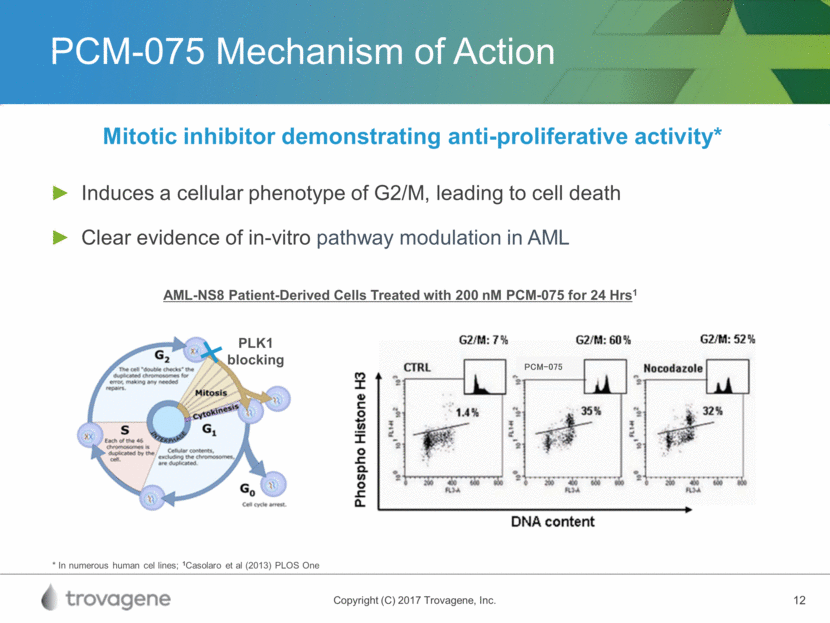
AML Market Opportunity1 AML: aggressive hematologic malignancy Incidence: 20,000* new cases and 10,400 deaths annually in the U.S. Prognosis: 5 year survival rate is 25% Treatment options vary based on patient condition / age, but can include: Chemotherapy Radiation Stem cell transplant Genetically diverse landscape: AML is known to be genetically diverse and PLK1 selectivity presents opportunity to work across patient sub-populations *Opportunity to pursue ODD designation. 1National Cancer Institute SEER 2016
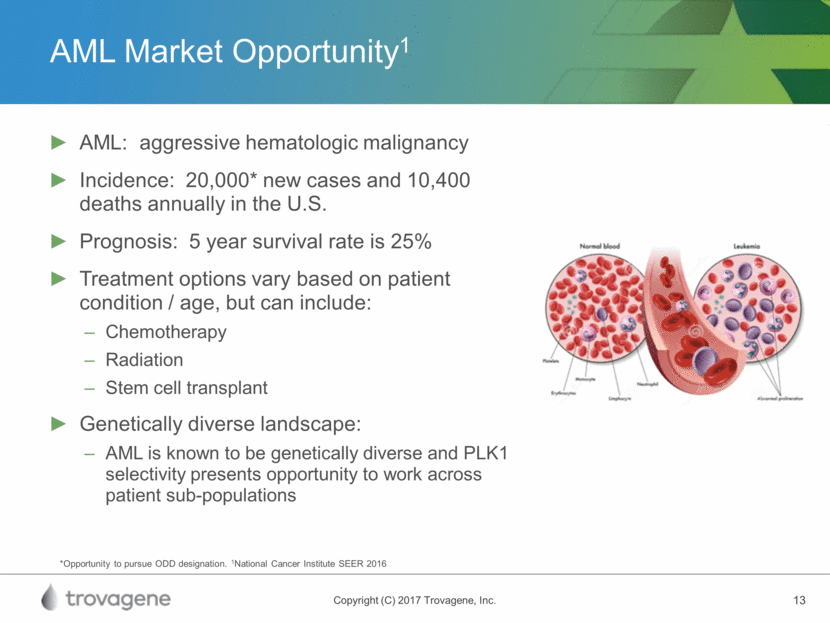
PCM-075 In-Vivo Activity Response observed in various xenograft models as a single agent and in combination1 Compound Median Survival Time (days) %TGI Placebo 28 Cytarabine 38 128.6 PCM-075 62 221.4 In Vivo Disseminated Leukemia Model (AML-NS8 Cells) Treatment with PCM-075 Started 20 Days Post-Inoculation 60 mg/kg BID (Days 1 and 2, 3 Cycles) 1Casolaro et al (2013) PLOS One Vehicle PCM-075 60 mg/kg BID Cytarabine 75 mg/kg Vehicle PCM-075 60 mg/kg BID Cytarabine 75 mg/kg

PLK Inhibition in AML Pan-PLK inhibitor demonstrated increased response rates, improvements in event-free survival, and overall survival benefit in combination with low-dose cytarabine (LDAC)1 Adverse events observed in Phase 3 study, potentially due to drug accumulation and pan-PLK inhibitor activity2 Opportunity for a more selective PLK inhibitor with less drug accumulation paired with a precision medicine diagnostic Clinical activity published on PLK inhibitors Compound Selectivity Half-Life (hrs) Dosing Clinical Activity in AML Volasertib pan-PLK 135 iv 25-30% CR+CRi (+LDAC)* PCM-075 PLK1 24 oral P1b/2 Trial *higher incidence of severe adverse events with volasertib plus LDAC in phase 3 study. 1Dohner et al. Randomized, Phase 2 Trial of Cytarabine with or without Volasertib in AML Patients Not Suitable for Induction Therapy. 2Phase 3 POLO-AML-2 Study of Volasertib – June 11, 2016 Press Release
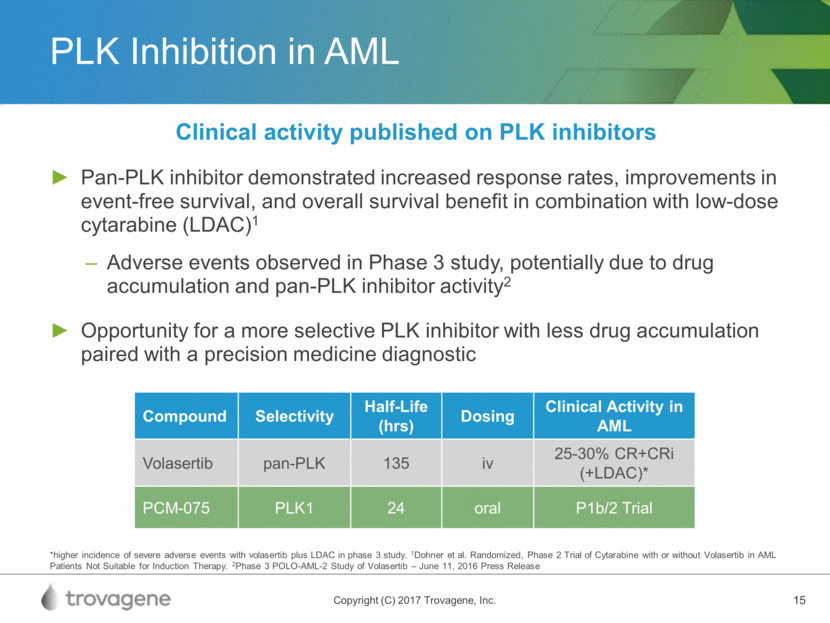
PCM-075 Phase 1b/2 AML Clinical Trial PCM-075 in Combination with Standard-of-Care (SOC) in Subjects with Acute Myeloid Leukemia Open-label trial to evaluate safety and anti-leukemic activity Phase 1b: dose escalation in combination with SOC to assess safety, tolerability, dose and scheduling, and determine recommended dose for Phase 2 continuation trial Phase 2: administration of recommended clinical dose in combination with SOC to further assess safety, tolerability and anti-leukemic activity Enrollment and Dosing Schedule Phase 1b – up to 42 subjects; Phase 2 – up to 32 subjects Starting dose in Phase 1b: 12 mg/m2, administered orally, in combination with SOC, for 5 consecutive days on Day 1 – Day 5, every 28-days Dose escalation by 50% increments until reaching the maximum tolerated dose (MTD), which will be considered the Phase 2 recommended clinical dose Trial Endpoints Safety: Characterization of safety, pharmacokinetics and correlative pharmacodynamic biomarkers Efficacy: Rate of complete response in Phase 2 defined as morphologic leukemia-free state

Phase 1b/2 Biomarker Assessment1 Biomarkers will be measured and correlated with pharmacokinetic drug levels to assess: Inhibition of PLK1 enzymatic activity Blockage of cell division (G2M arrest) Tumor cell death Blood sample (baseline) AML Patient + PCM-075 Blood sample (post PCM-075) Pre- and Post-Dose Blood Sampling 1TruSight Myeloid Sequencing Panel; Illumina
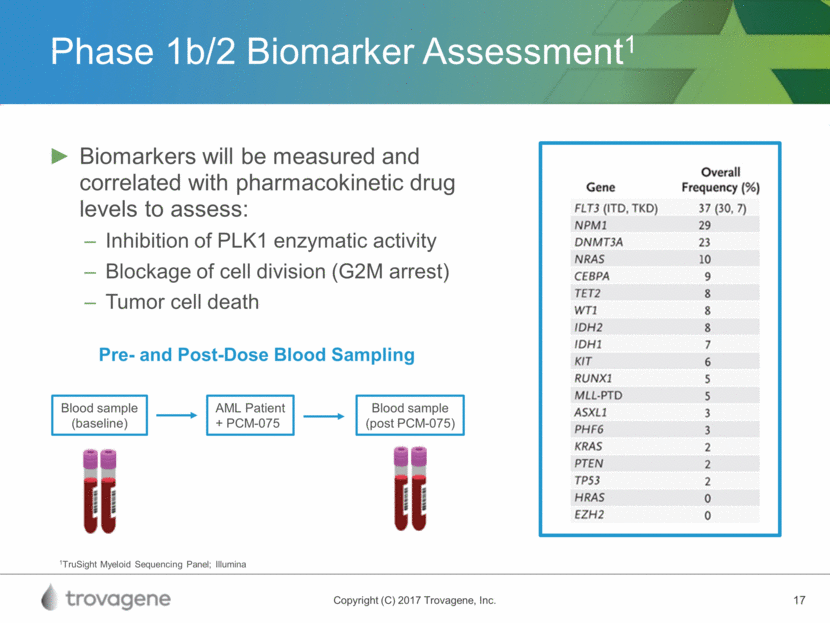
ACC Market Opportunity Adrenocortical carcinoma (ACC) is a rare cancer with significant unmet clinical needs Incidence: 0.7 to 2 cases per 1 million population per year1,2 Prognosis: 5-year survival in patients with metastatic disease is <15%3-7 40-70% of patients present with advanced or metastatic disease Patients with resectable tumors have 40% 5-year survival Treatment is mitotane, a highly toxic adrenolytic chemotherapy, approved in 1960 and remains the only approved therapy There is no treatment standard for advanced disease8,9 1Golden et al., J Clin Endocrinol Metab 2009;94:1853-78; 2Kebebew et al., World J Surg 2006;30:872-8; 3Icard et al, World J Surg 2001;25:891-7; 4Abiven et al., J Clin Endocrinol Metab 2006;91:2650-5; 5Assié G et al., J Clin Endocrinol Metab 2007;92:148-54; 6Fassnacht et al., Cancer 2009;115:243-50; 7Lughezzani et al., Eur J Cancer 2010;46:713-9; 8Fay et al., Crit Rev Oncol Hematol. 2014; 92: 123–132; 9Fassnacht et al, NEJM, 2012; 366:2189-2197 Malignant cells form in the outer layer of the adrenal gland
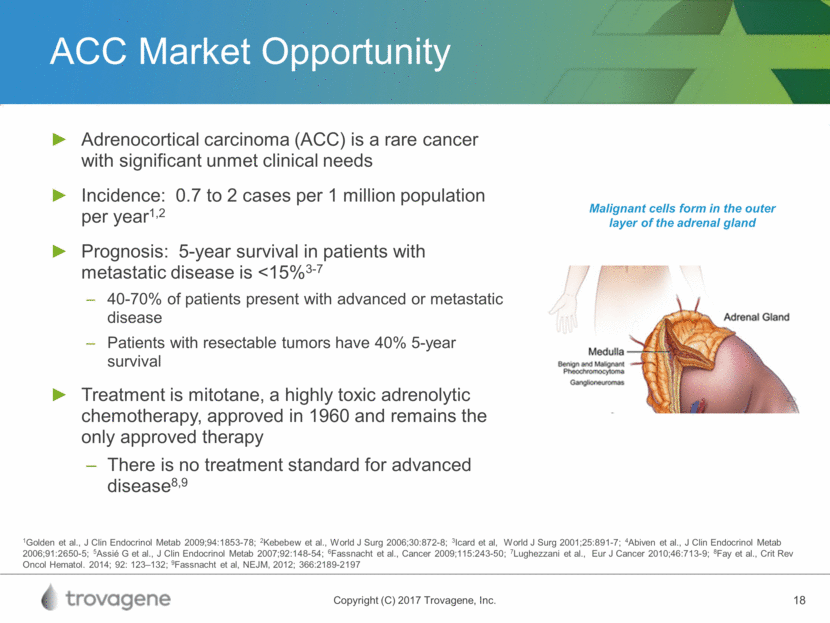
PLK1 inhibition in ACC: Therapeutic Opportunity 1Demeure et al.; ASCO-2016 Tumor Prior to Treatment Tumor Necrosis Following Treatment High PLK1 expression in ACC is associated with decreased patient survival Super-responder observed had high phospho-PLK1 expression prior to therapy Post-therapy biopsy indicated complete tumor necrosis Phase 1/2 study of PLK1 agent in patients with ACC1 Tumor Tumor Necrosis

Combination Therapy Opportunities High PLK1 expression is associated with the most aggressive forms of hematologic malignancies and solid tumor cancers PCM-075 may be synergistic and enhance the efficacy of current and future standard-of-care therapies 1Alphabetical order. 2Preclinical data on file with PCM-075 and these combined therapeutics Synergistic Drugs1 Cisplatin Cytarabine Doxorubicin Gemcitabine HDAC Inhibitors Pacitaxel Quizartinib (FLT3) Bortezomib Associated Cancers2 Liquid Tumors: Acute Myeloid Leukemia Acute Lymphocytic Leukemia Non-Hodgkin Leukemia Multiple Myeloma Solid Tumors Adrenocortical Carcinoma Triple-Negative Breast Small-Cell Lung Ovarian Sarcomas
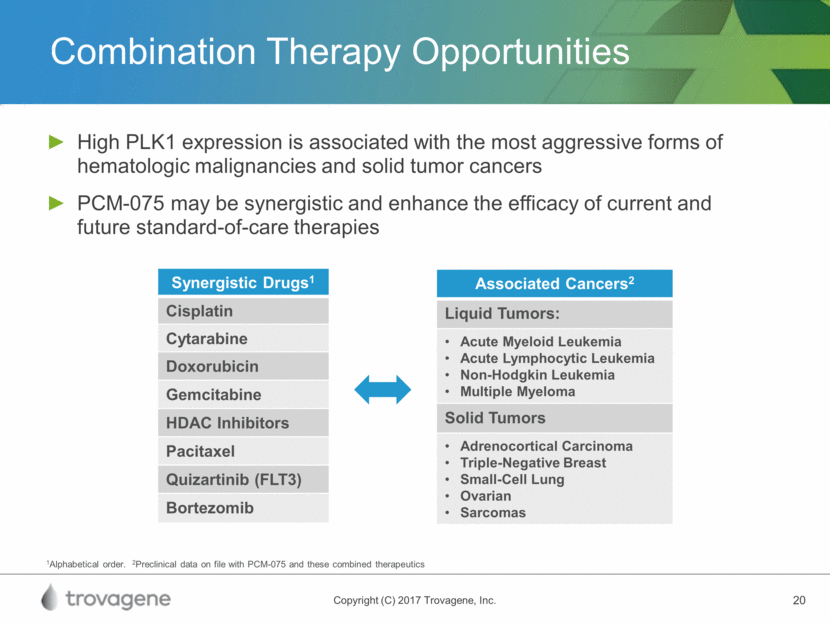
PCM-075 is Synergistic in Combination PCM-075 is synergistic with both targeted drugs and chemotherapeutics CI > 1.0 Antagonistic CI < 1.0 Synergy CI = 1.0 Additive *Data on File at Trovagene, Inc..
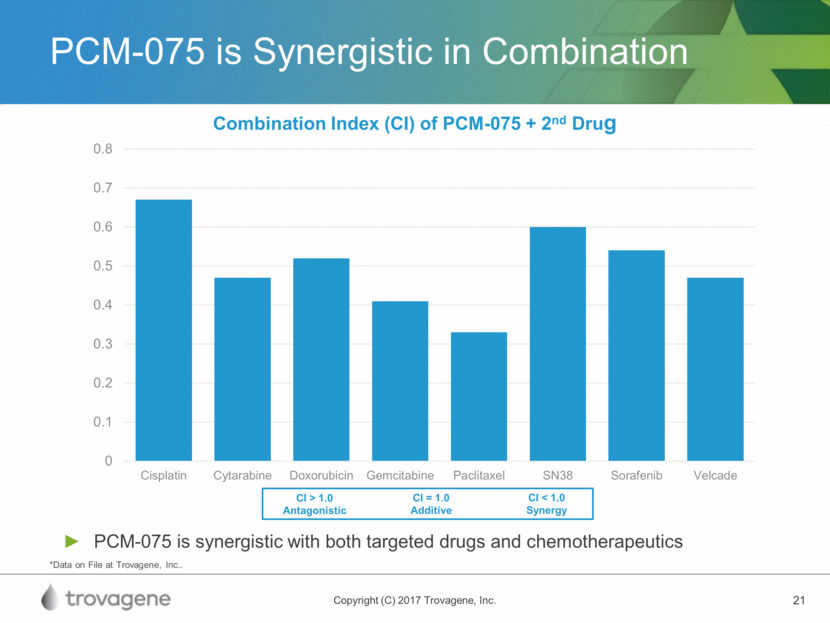
Acute Myeloid Leukemia (AML): Combination of PCM-075 with FLT3 Inhibitor Evaluation of the Efficacy of PCM-075 for MV-4-11 Human Acute Myeloid Leukemia (AML) Xenograft Model in NOD.SCID Mice 1Kindler et al, Blood 2010; 116:5089-10. 2Stone et al, N Engl J Med 2017; 377:454-64. 3Data on File at Trovagene, Inc. 30% of AML patients harbor a FLT3 mutation1 Available FLT3 inhibitors provide opportunity for combination with PCM-075 Midostaurin recently FDA approved; 3 additional FLT3 inhibitors are currently in Phase 3 clinical development2 The combination of PCM-075 and Quizartinib demonstrated 96% tumor growth inhibition and regression in FLT3 AML xenograft model3 Vehicle PCM-075 Quizartinib PCM-075 + Quizartinib
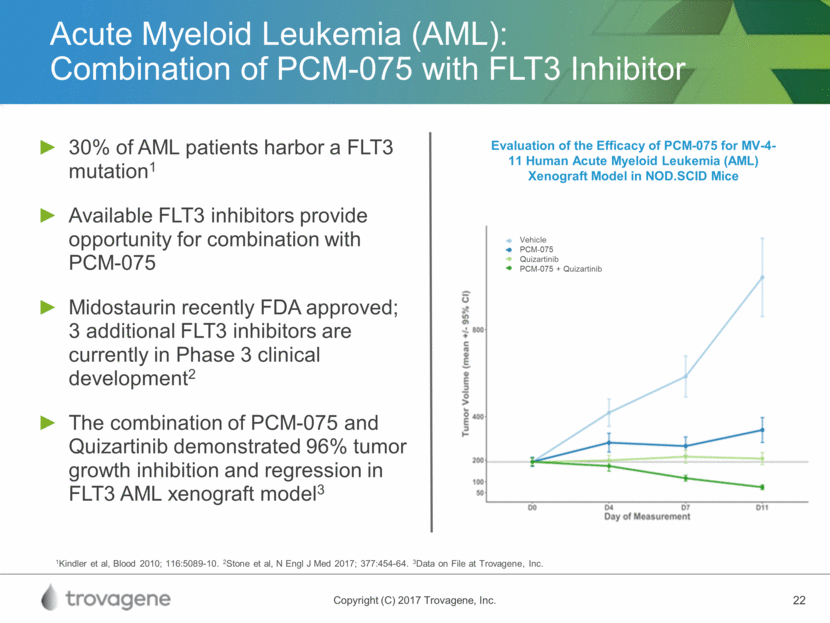
Non-Hodgkin Lymphoma (NHL): Combination of PCM-075 with histone deacetylase (HDAC) inhibitor Aggressive NHL progresses rapidly and accounts for 60% of cases in the U.S. Target population is relapse and refractory patients; there is no standard-of-care regimen and prognosis is poor Subtypes: Diffuse large B-cell lymphoma (DLBCL), including double-hit Mantle cell lymphoma Peripheral T-cell lymphoma (PTCL) PCM-075 demonstrates synergy with HDAC inhibitor of up to 80% in aggressive double-hit B-cell lymphoma cell lines1 1 Steven Grant, MD, Virginia Commonwealth University, Massey Cancer Center. Unpublished Research Data PCM-075 combined with HDACIs reduces survival of double-hit DLBCL and mantle-cell lymphoma cell lines1 Cell line Double-hit Cell line Mantle Cell Control PCM-075 HDAC PCM-075 / HDAC
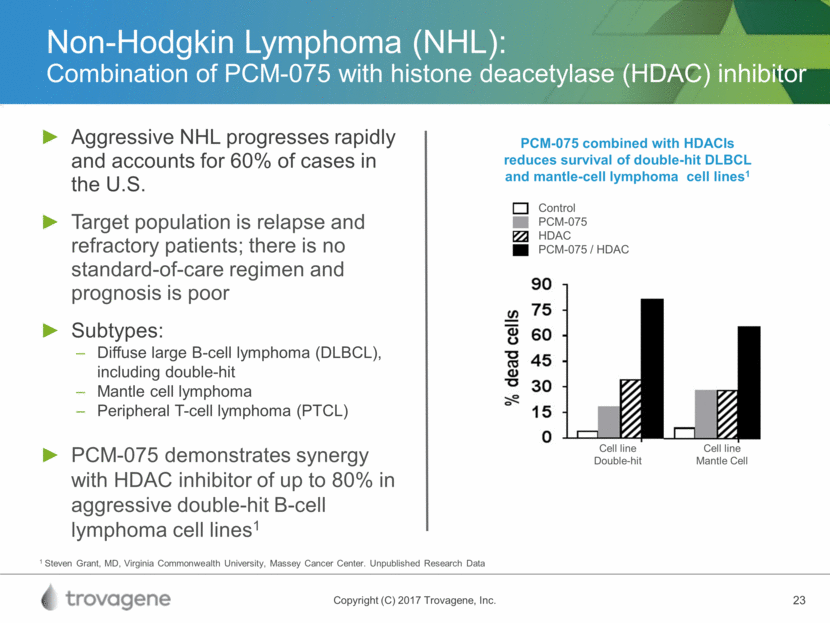
Sensitivity to PCM-075 in Breast Cancer Driven by Triple-Negative Cell Lines Triple negative breast cancer (TNBC) represents a significant challenge due to: aggressive clinical course resistance to chemotherapy lack of effective targeted therapies Polo-like kinase 1 (PLK1) is significantly overexpressed (p < 0.0001) in TNBC compared with the other breast cancer subtypes TNBC cell lines are significantly more sensitive to PCM-075 than in other breast cancer cell lines In TNBC patient-derived mouse xenografts (PDX), significant tumor growth inhibition was observed TNBC Cell Lines are Highly Sensitive to PCM-0751 PCM-075 Demonstrated Efficacy in Patient-Derived TNBC Xenografts2 High Low Median Sensitivity ER+ = 1000 nM Median Sensitivity TBNC = 49 nM 1Data on File at Trovagene, Inc. 2Data Presented at AACR - 2016

PCM-075 Summary PCM-075 is an oral, highly-selective PLK1 inhibitor with clinical development opportunities in hematological and solid tumor cancers Strong key opinion leader support for PCM-075 across numerous indications Highly synergistic with >10 chemo and targeted therapeutics, with broad clinical opportunities Phase 1 trial in solid tumors established safety of PCM-075 and identified a recommended Phase 2 dose of 24 mg/m2/day Phase 1b/2 trial in AML initiated: Dr. Cortes (MD Anderson) as lead investigator, ten trial sites identified, site-activation in process Phase 2a protocol for Adrenocortical Carcinoma (ACC) in development with leading key opinion leaders Ongoing preclinical evaluation in Small-Cell Lung Cancer (SCLC), Non-Hodgkin Lymphoma (NHL), Triple-Negative Breast Cancer (TNBC) and Castrate-Resistant Prostate Cancer (CRPC)
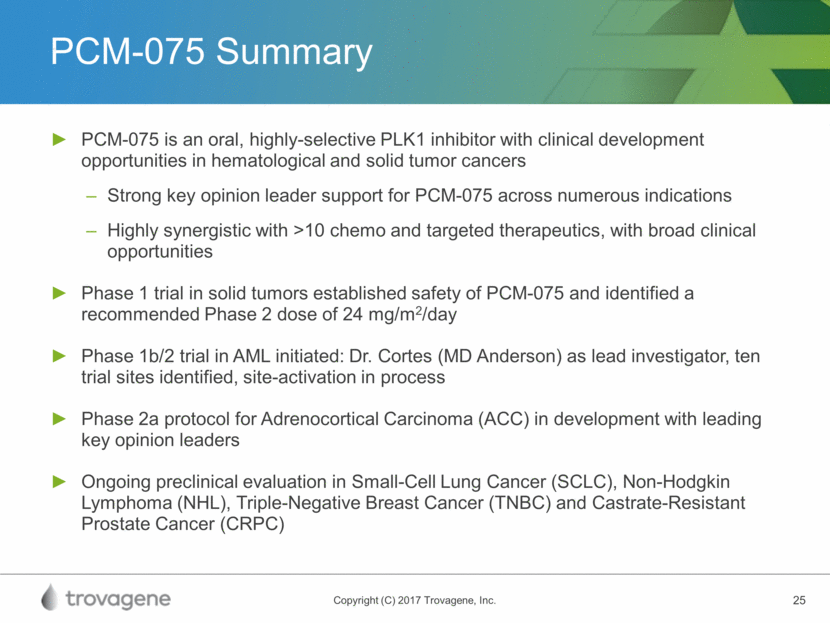
Value Inflection Points PCM-075 AML Phase 1b/2 Clinical Trial Activation and execution Open-label: interim data throughout Completion of Phase 1b dose escalation Pharmacokinetic and Pharmacodynamic analysis Commencement of Phase 2 PCM-075 Clinical Development in Other Cancer Types Development and submission of ACC Phase 2 protocol to FDA Expansion of clinical studies in hematologic malignancies and solid tumors: NHL, SCLC, CRPC, TNBC Commercialization Precision Diagnostics royalties and business development Precision Therapeutics business development Presentations and publications
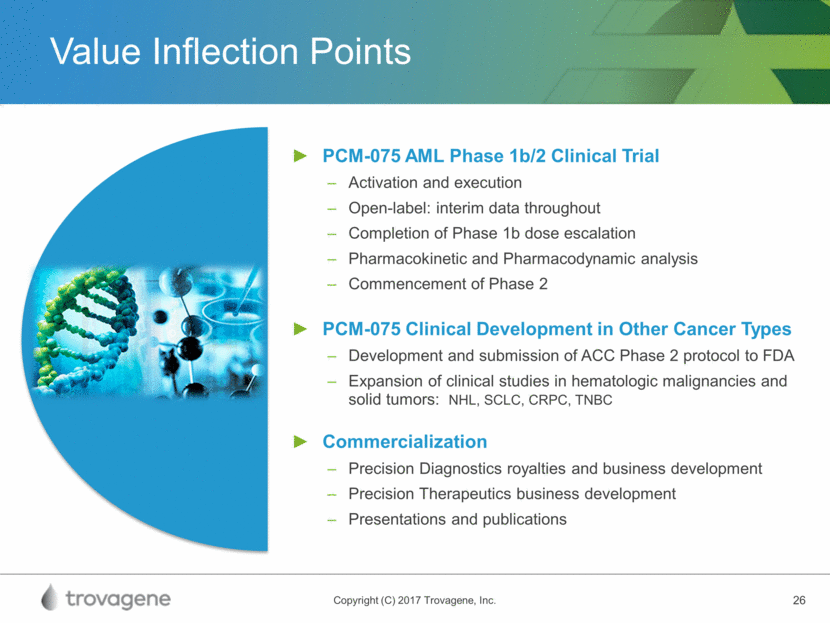
Thank you for more information, please email ir@trovagene.com

